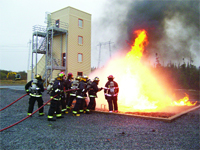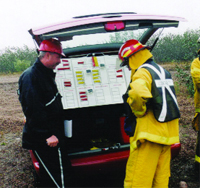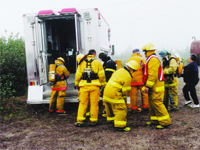
Features
Training
Nuclear management: Unique Point Lepreau ICS combines plant personnel; local, regional departments
The adage that two heads are better than one has been expanded on at Atlantic Canada’s only nuclear generating station.
April 28, 2008
By Andrew A. Sanojca
 |
| Saint John firefighters advance on an industrial firefighting prop at the Point Lepreau Generating Station during a training exercise. PHOTOS COURTESY ANDREW SANOJCA |
The adage that two heads are better than one has been expanded on at Atlantic Canada’s only nuclear generating station. The Point Lepreau Generating Station (PLGS) is operated by NB Power and uses three chief officers from three organizations at its command post during an incident. How they all arrive is a story in itself.
Hazards within a nuclear facility are the same as would be found at most large manufacturing plants. Fires would likely involve office spaces, Class “B” fuels such as lubricating oil and Class “C” hazards such as electrical panels. There are also many support buildings, used for office space or materials storage. The processes involved for the production of nuclear power are all within a contained structure and present little fire risk. The concern is with all that is required to support the process.
When an incident is reported to the main control room, the plant’s response team is notified via the public address system. The response team comprises employees who work at various jobs throughout the plant and in adjacent offices. The seven members include a plant operator, who assumes the role of incident commander, and is called the response team leader or RTL. There are four members designated as firefighters, who form an attack team and a backup team. Two other members, who are also firefighters, assume the role of medical (first aid) and accountability but are fully equipped and can enter the hot zone if the other four require immediate assistance. These response team members meet at a muster room within the plant to don their gear then proceed to the incident location.
The RTL assumes command and radios his findings back to the plant’s control room, which can ensure that power is cut off to certain areas or can let the RTL know of any other hazards in the area. The RTL and the control room operator co-ordinate how the incident, whether it is a fire or spill, will be dealt with.
For a report of a fire or fire alarm activated, the control room will call 911, which puts it in contact with the Saint John Public Safety Communications Centre (PSSC). PSSC will dispatch the Musquash Volunteer Fire Department and the Saint John Fire Department, which holds a contract with NB Power to provide fire suppression at the plant.
 |
| The accountability board set up in the back of the Musquash Fire Department van, showing personnel assignments with timers to track "on air" time. |
When Musquash Fire Department arrives on scene, the role of the first two arriving members are to take over accountability from the response team member, and for the senior officer or firefighter to establish a joint command post with the response team leader. Once the PLGS accountability member has briefed the Musquash accountability member, he can then become an escort for incoming firefighters. An escort is used because of the complexities of the plant and the hazards within it, which would not be well known to outside firefighters. It has become policy that a response team member is required to accompany all outside agency firefighters. The medical officer will also be relieved, either when an ambulance arrives to standby or when a first-responder trained firefighter has arrived on scene. This person will also then be available as an escort for incoming firefighters.
The Musquash incident commander will take over control of the situation and lead the tactical operations of the firefighting crews. The Lepreau response team leader stays with the Musquash IC and assists by providing technical knowledge and checking with the control room about hazards in the area of the fire.
Additional resources from the Musquash Fire Department will stage at an appropriate location and be prepared to relieve the first in crews from the response team. If available, a staging officer and rehab officer will be designated from the Musquash resources.
When the Saint John Fire Department arrives, the district chief will report to the command post and receive a briefing from the Musquash incident commander and the Lepreau Response team leader. When ready, he will then assume overall command of the incident. The Musquash IC will remain at the command post and change radio channels to communicate with the accountability officer. The responsibility of the Musquash commander then shifts to providing resources to the SJFD incident commander and maintaining staging and accountability.
 |
| Staging and rehab is generally set up in the area of the Musquash Rescue unit allowing firefighters a chance to rest before their next assignment. |
During each of the hand offs of incident command, the new commander operates on the tactical fireground channel. The outgoing incident commander changes to a separate channel to continue in his new role. Once all three people are at the command post, three separate radio channels will be in use, allowing for a smooth flow of information back and forth. The Musquash IC will have switched to a separate channel to talk directly with accountability and staging so that as additional resources are required, he can call for them to be sent to their assignments.
The staging and accountability officers will operate on the Musquash Fire Simplex channel with the Musquash IC, but will also each monitor the fireground operations channel, now in use between the firefighters and the Saint John district chief. This additional monitoring allows for two things: it lets the accountability and staging officers know a step earlier that additional resources will be called for; but, more importantly, it provides two extra sets of ears to monitor the firefighting operation in case of a distress call.
Wayne Pollock has been the fire chief of the Musquash Volunteer Fire Department for 20 years and has remained a constant through the development of this system. He has worked with different response team leaders and district chiefs over the years and is happy with the system as it stands.
“This is a system that we have built as a team, between our department, the nuclear plant and Saint John. It is specific to our requirements, and through many years of drills we’ve learned what works well and what needed changed and improved. We’re at a point now where everyone knows their role, and is comfortable with each agency’s capabilities.”
Angus Monks, the nuclear training officer at Point Lepreau, called the unified command structure the best in the Maritimes.
“By working together we have become more team based and hands on. We understand the task and challenges ahead through pre-fire plans, fire assessments and by developing good training programs that incorporate classroom, live fire and drills, we have developed open relationships among all agencies.”
While the explanation of this system may sound complicated, it does indeed work quite well. The system is practised regularly, with briefings and hand offs of command during exercises held among all three agencies on a regular basis. A fire incident at this facility may involve a small out building or a ruptured oil or lubrication pipeline. The use of this unified command model ensures that all incidents are handled safely, using the knowledge of the response team members and the firefighting resources from the Musquash Volunteer Fire Department and the Saint John Fire Department.
Print this page
Advertisement
- Opening doors; Airbags, rollover protection challenge rescuers
- Model behaviour: Managing change in the fire hall